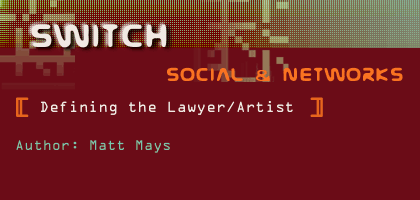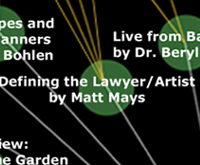 |
 |
 |
 |
|
This is more than jazz; this is theater with scenery, lights and full orchestra.
-- Time Magazine on David Boies [1] In the collaborative environment of the deposition, a work is created by the interaction between the Lawyer/Artist, the law and the deposed. A dynamic literature is created under the ontology of law, where the objects of correspondence, articles and other evidentiary exhibits act as pre-existing classes of knowledge and fact. In real time the Lawyer/Artist queries the system seeking to exploit synaptic disconnects and create new associations. Consider the following exchange:
Boies creates a play between his own intentions and the evading intent of the deposed, creating a rare real-time deconstruction of the Bill Gates image and inserting the non-linear associations of freedom, childhood and the deceptive intent of anti-competitive monopolistic practices. This newly created dialogic community behaves as any other art; both become an assembly of interactions to be documented, labeled, exhibited, and theorized upon. The Brief/Manifestos, decisions, and oral arguments become the manifestations of the work for display in the museum of public record. These then become part of the legal detritus of Lexis/Nexis as the system feeds into itself creating the self-referential network of stare decisis-precedent. Much as the performance artist manipulates time, the Lawyer/Artist exploits it. The scenery and players are laid out not to create a network of thought and ideas, but to generate profits for the firm's equity partners. Time is a commodity and a medium upon which works are created -- the client is patron and the billable hour is the commission. The Lawyer/Artist is not concerned with the law and its spirit, instead he is concerned only with the Client/Patron's will and the desired remedy. In the case of strategic litigation even a specific remedy is not desired, only delay or harassment as law for law's sake. (.. C O D E I S L A W I S A R T ..) Lawrence Lessig, in a series of articles for the Industry Standard and in his book Code and Other Laws of Cyberspace, argues that "code is law." He outlines the four interlocking constraints that operate on a subject of regulation: the law, social norms, architecture, and the markets. Clearly art is already involved in these influences: performance art experiments with social norms; architects are viewed as artists creating the designs of the public and private spaces we move in; organizations such as eToy and c5 operate in the market space. Lessig's point is that the Internet provides a new opportunity for legislation of architecture; this time meaning the architecture of code. The Lawyer/Artist operates in this space between the law and architecture, influencing the regulated through the Application layers of the Internet.
The OSI (Open Systems Interconnection) standard is "a standard description or 'reference model' for how messages should be transmitted between any two points in a telecommunication network." [3] IP is currently the standard for the network layer, and TCP and UDP operate on the transport layer. The Lawyer/Artist does not usually operate on the lower network transport layers, but instead interacts with the OSI standard's upper layers: Application, Presentation, and Session. Boies the Lawyer/Artist operates in this space, most recently through the works for the Client/Patron Napster.
Here Boies is redefining the media of the past into a meta-medium of innovation, again defending his Client/Patron against what is portrayed as the hegemonic tendencies of corporations. In this case Napster's innovation legacy is established by interacting with the code of the Internet's upper OSI layers. Boies once again queries the network of precedent; this time relying on Sony Corp. of America vs. Universal City Studios, Inc. [5]. He then attempts to convince the appellate Judge/Theorists that Napster's "code," the directory server and associated session protocols, creates an architecture that facilitates substantial non-infringing uses. The influences of law and architecture on the regulated are combined through the regulation (or non-regulation) of this code. As more and more creative works are distributed and collaborated upon on the Internet and other networked environments, the infrastructure of these environments remains subject to legislation. Lessig argues that if the Internet is allowed to grow under a perfect commerce system, infrastructure will develop to ensure accurate authentication in the transaction process. As Lawyer/Artists work in the media of law to affect peer-to-peer networking and operating systems, infrastructures will be built under these judicial interpretations that should concern today's networked artists. Boies, known for never using computer, is shaping networked media more than the networked artists themselves by manipulating the architecture of the Internet through law. (.. M A R K E T I N G T H E L A W Y E R / A R T I S T ..) The master of schadenfruede, Boies turns misfortune into a marketing opportunity. The greater his losses the more famous he becomes and the more his Lawyer/Artist legacy grows. Even this is calculated: the simultaneous perception of Boies as genius and as loser implies a flawed system, not a flawed lawyer. In the theater of advertising as performance, Boies is a master of deliberate self-promotion and media manipulation. David Boies the Maverick David Boies the Genius Does David Boies know he is a Lawyer/Artist? Is he self-aware of his ontological queries into stare decisis interaction matrices? Yes, but within the commission of the billable hour. Self-expression is not part of the equation. He works for the money and is indifferent to the subject matter of his creations. David Boies the Humanitarian Judith Boies, David Boies' ex-wife and fellow Lawyer/Artist, says "Part of the reason he does so well ... is that's really him you're seeing in court." [6] Boies the Lawyer/Artist is able to realize image transpositions as to become part of the work itself, a living manifestation of the tactical queries into the Client/Patron's will. In an ongoing dialogue with the capitalist context, his works of self-image innovation incorporate tenets of marketing and branding into his work further expanding the reference points of his ontological queries. (.. C O N C L U S I O N ..) If law is code, Boies writes it clean by defining his primary algorithm of remedy creation, calling the predefined functions of legal processes and involved parties, and globalizing his variables of argument across media representations. Strategic and tactical decisions between his Brief/Manifestos, depositions, and oral arguments must be coordinated with image transfigurations. This approach draws on trends of the artist mirroring contemporary corporate structures and processes. The Lawyer/Artist will continue to be neither a social activist not a seeker of self-expression, but will instead continue to create works that explore systems of knowledge through the real-time queries of the network of precedent. While the works themselves may be of de facto social importance, the Lawyer/Artist's only goal is the desired remedy of the Client/Patron. Endnotes [1] http://www.time.com/time/poy2000/mag/boies.html [2] http://www.zdnet.com/zdnn/special/msdojdepos/msgates0827.html [3] http://whatis.techtarget.com/WhatIs_Definition_Page/0,4152,212725,00.html [4] http://dl.napster.com/brief0818.pdf [5] http://www.eff.org/pub/Legal/Cases/sony_v_universal_decision.html [6] http://www.time.com/time/poy2000/mag/boies.html ================== Matt Mays is a freelance interaction designer/programmer and graduate student in the CADRE program. More on his various endeavors can be found at http://www.cosmodrome.com. |